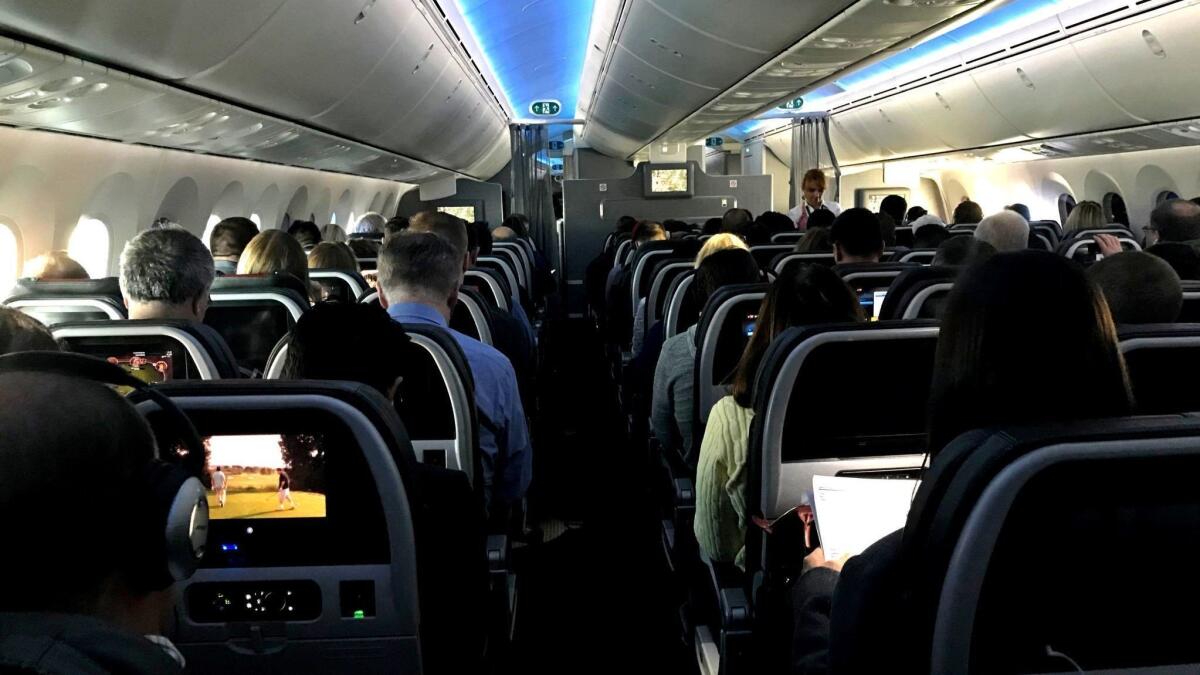Your airplane seats may be comfier and smell better in coach cabin of the future

- Share via
Commercial flying may have lost its mythical appeal from the bygone jet age — think crowded budget carriers, dour catering and the premature demise of the majestic Airbus A380 airliner — but aerospace companies are still trying to improve the passenger experience on aircraft. In the hyper-competitive world of aviation, more comfort in the cabin can also be a major selling point for airlines, and cabin amenities (or the lack thereof) are often-discussed features on social media.
At the annual Aircraft Interiors Expo in Hamburg, Germany, the biggest showcase for cabin innovation, more than 500 exhibitors presented new seats, fabrics, lights, in-flight entertainment systems and creative layout concepts. One big trend at this year’s show: making better use of the data generated in the cabin to provide a more customized passenger experience, support flight attendants and improve maintenance of complex business-class seats or kitchen areas.
Here are some of the key trends and features presented at the trade show.
Feeling at home
Over the decades, seat and cabin fabrics have veered from psychedelic tones to muted ones. The latest trend is a more homey feeling. Lantal Textiles, an aircraft fabric manufacturer, showcased cabin curtains with a more plush, three-dimensional weave, and Lonseal Inc. presented flooring that mimics the grainy details of wood for a more soothing atmosphere.
Mood lighting continues to be a major force of cabin innovation, but the new generation of LED lights also enables airlines to considerably cut weight. Collins Aerospace introduced a reading lamp that can adapt to different applications, from large spot to small target, with full-color options, eliminating the need for additional elements such as sidewall lighting.
Getting comfortable
Flat-bed seats in business class and first class have been a feature for more than a decade, but the humble economy seat has remained largely built for purpose: slender, lightweight, limited comfort. Recaro Holding presented a redesign of its CL3710 back-of-the-cabin seat built especially for long-distance routes, which features additional sleeping aids such as wrap-around head support and a retractable ledge to extend the seat and provide more thigh support. Feeling too hot or cold? Lantal is working on a temperature-control system that enables fliers to cool or heat their seats.
At the more luxurious end of the spectrum, Airbus is experimenting with a new seat layout that it calls the settee corner, combining a single-person seat with a bench design that can be used for meetings during flight or to spread out for a nap.
Scents and sensibility
Feeling nauseated because there’s a stale smell wafting through the cabin? Panasonic Avionics Corp. is bringing an air-deodorizing system that purifies the area around a (business) passenger’s seat, using nano-sized electrostatic atomized particles to neutralize air and battle viruses and bacteria. At the Hamburg show, engineers showcased the technology using a piece of cloth infused with the dubious odor of stale French fries. After about a minute of bursts from the nano-particle stream, the smell was of clean sheets.
Meanwhile, at Fokker Technologies, engineers are working on infusing the cabin with distinct fragrances. The company is collaborating with cosmetics brand Rituals on a product that distributes scents through the air-conditioning system, promising greater passenger comfort or the ability to create signature airline scents for better brand recognition.
Mapping it out
Although in-flight entertainment has come a long way since movies were projected onto a screen with the resolution of a bathmat, the media offerings are still a far cry from a dedicated, personal experience for each passenger. In-flight maps remain one of the most popular features in the cabin, but they haven’t caught up with the immersive features prevalent on smartphones and tablets.
Panasonic has created a map that uses personal travel information from a passenger’s loyalty-program profile and integrates it with in-flight entertainment features and details of the surroundings as well as the flight’s destination. Coming to airlines next year, the map also enables passengers to use FlightAware data that follows flight paths of other aircraft.
Smart bins
Few things are more tedious than standing at the luggage carousel after a long journey, which is why more people try to cram their suitcases into the overhead compartments. Airbus and Boeing have both been working on bigger bins, and Boeing showcased the new layout of its 777X wide-body aircraft. Airbus also wants to make the compartments smarter, using sensors that track whether a bin is in use as well as the weight of the loaded luggage, providing vital data to the airline about occupancy rates. At some point in the future, Airbus wants to give passengers the option to book spots in the compartments; that way, travelers could avoid jostling for storage space while boarding the plane.
More to Read
Inside the business of entertainment
The Wide Shot brings you news, analysis and insights on everything from streaming wars to production — and what it all means for the future.
You may occasionally receive promotional content from the Los Angeles Times.










